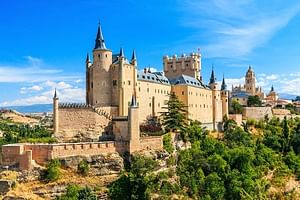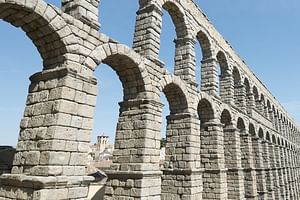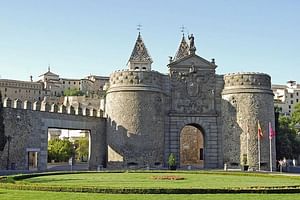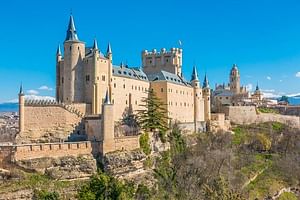Discover the “City of the Three Cultures” by yourself!
Toledo is located 70 km away from Madrid, a beautiful city-museum declared World Heritage Site by UNESCO. It is one of the oldest towns in Europe and has a great artistic beauty and buildings from almost all periods in history (Arabian, Gothic, Mudejar, Renaissance and Baroque style). Toledo is called the “City of the Three Cultures”, since Christians, Muslims and Jews lived together. In the XVI century, it was also the place of residence of the great painter El Greco.
Once in Toledo, you will arrange your day in Toledo as you like. 1 hour guided walking tour in Toledo is included.
The tourist wristband gives you access to 6 of the most important monuments in the city: Synagogue of Santa María la Blanca, Church of los Jesuitas, The Church of Santo Tomé-Burial of the Count of Orgaz, Monastery of San Juan de los Reyes, Mosque of Cristo de la Luz, Royal College of Doncellas Nobles and the Church of El Salvador.
Duration
The tour starts at
-
Madrid
We start at 09:00 am our tour to go to the city of Toledo
-
Toledo
One hour after , we have arrived in Toledo to see the City of the Three Cultures. We will start our visit to the city from the Plaza del Granadal.
Synagogues, mosques and churches stand together in Toledo's historic quarter, a testament to the medieval Spanish city's diverse history. The four towers of The Alcazar, a fortress built in 1085, d...
Synagogues, mosques and churches stand together in Toledo's historic quarter, a testament to the medieval Spanish city's diverse history. The four towers of The Alcazar, a fortress built in 1085, dominate the skyline. Toledo and its surrounding countryside inspired El Greco, and his paintings are on display in many places around the city, including the museum that bears his name.
-
Plaza de Zocodover
From here we will start the visit of an hour and a half with our guide. Then we will have free time to visit the monuments included with the Tourist Bracelet.
The Plaza de Zocodover is a square of the city of Toledo, in the autonomous community of Castilla la Mancha. It was the nerve center of the city during most of its history, acting ...
The Plaza de Zocodover is a square of the city of Toledo, in the autonomous community of Castilla la Mancha. It was the nerve center of the city during most of its history, acting as its main square. A part of it was designed by Juan de Herrera in times of the reign of Felipe II. Here horses, donkeys, foals, mares, mules and other beasts were sold, when the city of Toledo was Spanish-Muslim city. Here was organized the most important market of the city. It has been celebrating for centuries, it is a weekly market. Today it celebrate on Tuesday in the vicinity of Paseo de Merchán or de la Vega.
-
Iglesia de Santo Tomé
Its fame is mainly due to the fact that it contains the painting The Burial of the Count of Orgaz by El Greco, which can be seen by accessing the back of church.
The parish church must have been founded after the Christian Reconquista of the city by Alfonso VI in 1085, as the first news that we have of its existence is from 1142....
The parish church must have been founded after the Christian Reconquista of the city by Alfonso VI in 1085, as the first news that we have of its existence is from 1142. From the first Mudejar building, it has kept the large multifoil arch superimposed upon the main arch that separates the main nave from the presbytery together with the sturdy buttresses of this part of the nave and a small trefoil arch on a brick frieze arranged in Mudejar style that survives in the high part in what used to be the semicircular sanctuary of the original single nave church.
-
Monasterio de San Juan de los Reyes
The Monastery of San Juan de los Reyes (English: Monastery of Saint John of the Monarchs) is an Isabelline style Franciscan monastery in Toledo, in Castile-La Mancha, Spain, built by the Catholic Monarchs (1477–1504).
This monastery was founded by King Ferdinand II of Aragónn and Queen Isabella I of Castille to commemorate both the birth of their son, Prince John, and their victory ...
This monastery was founded by King Ferdinand II of Aragónn and Queen Isabella I of Castille to commemorate both the birth of their son, Prince John, and their victory at the Battle of Toro (1476) over the army of Alfonso Vi of Portugal. Prince John of Portugal also celebrated his victory over the Castilian army of the Catholic monarchs with a solemn procession on each anniversary of the battle. This apparent contradiction was a consequence of the indecisive military outcome of the battle: the troops under Afonso V broke while the forces led by Prince John of Portugal defeated the Castilian right wing and remained in possession of the battlefield.
-
Mosque of Cristo de la Luz
The Mosque of Cristo de la Luz is a former mosque in Toledo, Spain. It is the one of the ten that existed in the city during the Moorish period. The edifice was then known as Mezquita Bab-al-Mardum, deriving its name from the city gate Bab al-Mardum.
Built in 999, the Old Mosque, current Hermitage of Cristo de la Luz, is the oldest standing monument in the city of Toledo.
Small but very rich in history and art. Its simil...
Built in 999, the Old Mosque, current Hermitage of Cristo de la Luz, is the oldest standing monument in the city of Toledo.
Small but very rich in history and art. Its similarities and differences with the great mosque of Córdoba make it a tourist attraction that you should not miss if you come to see Toledo and want to soak up its multicultural history.
The Islamic Toledo, very unknown to many, enjoys a relevant significance in this singular building. The Toledo of the three cultures made a building: the achievement of civilizations that starred in much of the history of our city becomes a reality in this mosque converted into a church.
The legend of Cristo de La Luz, one of the best known, leaves no one indifferent …
.... don't you know it? Come discover it!
-
Mezquita-Iglesia de El Salvador
The current church is still oriented south-east, in the direction of Mecca. It survived the conquest of Toledo by the Christian armies in 1085, to be turned into a church in 1159.
The current church is built on the mosque, so it is oriented southeast in direction toward Meca. For which construction, different elements of the previous Visigothic bu...
The current church is built on the mosque, so it is oriented southeast in direction toward Meca. For which construction, different elements of the previous Visigothic building were reused, because of that a horseshoe arcade supported on Visigothic pilasters has been preserved with sculpted decoration of figurative themes, unusual in this type of remains. The Pilaster of El Salvador, shows in one of its faces various Visigothic miraculous scenes from the life of Jesus: the Cure of the Blind, the Resurrection of Lazarus, the Samaritan and the Hemorroísa, as well as other themes of eucharistic hue that alluding to Christ as the salvation. Its crude treatment shows the abandonment in which the work had fallen on the stone.
Although it conserves the shape of the minaret, that carries incrustations of borders, in 1159 it made several Christian modifications, and the construction in the end-15th century of the Gothic chapel of Santa Catalina. The tower corresponds to the minaret of the mosque, with a Baroque brick addition at the body of the bells.
It is dedicated to St. Savior. The church suffered a fire in the 15th-century, which forced an important restoration. Álvarez de Toledo was commissioned to the restoration and he adds new chapels highlighting the chapel of Santa Catalina.
-
Synagogue of Santa María la Blanca
Erected in 1180, according to an inscription on a beam, it is disputably considered the oldest synagogue building in Europe still standing. It is now owned and preserved by the Catholic Church.
The synagogue is a Mudejar construction, created by Moorish architects for non-Islamic purposes. But it can also be considered one of t...
The synagogue is a Mudejar construction, created by Moorish architects for non-Islamic purposes. But it can also be considered one of the finest example of Almohad architecture because of its construction elements and style. The plain white interior walls as well as the use of brick and of pillars instead of columns are characteristics of Almohad architecture. There are also nuances in its architectural classification, because although it was constructed as a synagogue, its hypostyle room and the lack of a women's gallery make it closer in character to a mosque. Though it does not have a women's gallery today, an early twentieth century architect suggested that it did at one time have a one.
The synagogue was turned into a church in 1405 or 1411, but without any major renovations. It took at that time the name of Santa María la Blanca (Saint Mary the White) and today it is most commonly known by this name.
-
Plaza del Granadal
From this place we will start our return to Madrid at the time agreed by the guide.
Round Trip bus to Toledo With Air Conditioned and Official Guide on the Bus
Bus Panoramic Tour of Toledo and stop at Mirador del Valle (Breathtaking views)
Tickets to:
Synagogue of Santa María la Blanca
Church of Jesuitas
Mosque of Cristo de la Luz
The Church of Santo Tomé-Burial of the count of Orgaz
Royal College of Doncellas Nobles
Church of El Salvador
San Juan de los Reyes and Jesuit Church
Food and drinks
Tickets fees to monuments not specified above
Gratuities













